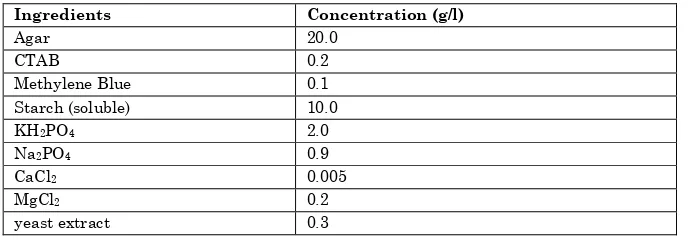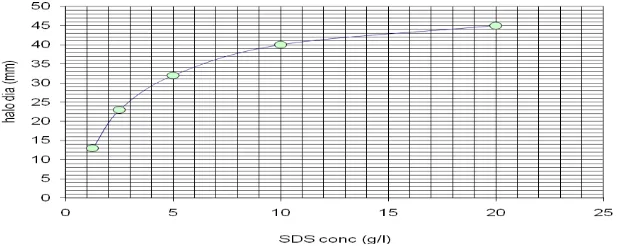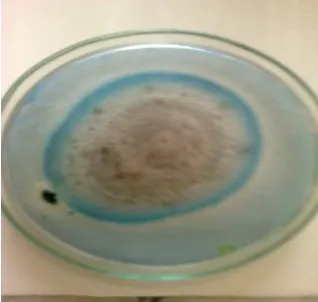ISSN 2286-4822
www.euacademic.org DRJI Value: 5.9 (B+)
Evaluation of Different Nitrogen Sources in
Production of Biosurfactant by Mycoflora of
Southern Punjab Pakistan
EJAZ HUSSAIN FARHAT SHAFI MIRZA AHSEN BAIG1 MUHAMMAD TAJAMMAL KHAN
Microbiology Laboratory Institute of Pure and Applied Biology Bahauddin Zakariya University, Multan Pakistan GHAZALA YASMEEN BUTT
Phycology Laboratory Department of Botany GC University, Lahore Pakistan
Abstract:
The study was conducted to evaluate the effect of different nitrogen sources on the production of biosurfactants from locally isolated mycoflora of Southern Punjab Pakistan. Several fresh isolated fungal strains were screened by which Aspergillus niger EH6o was observed to best surfactant production (≥20 g/l of glycolipids) among all the strains. Further optimization was performed to Aspergillus niger EH6o by using different nitrogen sources (NaHCO3, NH4Cl,
(NH4)SO4, NaNO3, NH4NO3) at pH (2.5-8.0) temperatures (20-60ºC)
and incubation periods (24- 120 h). Aspergillus niger EH6o was observed to gave maximum surfactant yield (25g/l) at 0.5% NaNO3
provided with 0.1% olive oil (initial pH 5.5) when hatched at 27°C for
96h. In Conclusion, as the economical point of view the crude
surfactant produced by Aspergillus niger EH6o were observed to have improved qualities when tested with commercial surfactants like CTAB and SDS.
Key words: Biosurfactant, Southern Punjab, mycoflora, Aspergillus niger, EH6o.
Introduction
Biological surfactants are the microbial products which minimize the surface and interfacial tension between individual molecules at particular surfaces and interfaces. Biosurfactants possessed many advantages at chemical surfactants due to their biodegradable and eco-friendly nature that is the point which make them much more interest in creating the era of green technology (Bhardwaj et al., 2013). In recent years, biosurfactants from bacteria and fungi have gained more attention for their antifungal activity, low toxicity to plants and animals, low irritation, compatibility with human skin and high biodegradability (Vijaya Dewaliya and Raashi Jasodani., 2013). The microorganisms which produce biosurfactants can also be used in the diverse bioremediation technologies like removal of oil from contaminated soil, solubilisation and sludge in oil storage tank (Qazi et al., 2013). Biosurfactants are not widely used in industry because of their high production cost and complex process development. The critical factors adding to the economic inefficiency of biosurfactants include expensive medium, low yield, impure product and high cost of downstream processing (Syldatk and Hausmann 2010).
Materials and Methods
orange, guava, apple, date palm, corn, mango, rice, were collected from various orchids and markets of Southern Punjab Pakistan in sterilized polythene bags Table 1.
Table 1.The strains isolated from samples collected from different areas of southern Punjab, Pakistan.
Sr.No. Strain Source Sampling location Elevation Date & Time
1 SS6da1 Gossypium plant
30°11.526SE,
071°28.728 NW 512◦
17-10-10; 10:00 am 2 MTKC1 Psidium plant 30°11.411SE,
071°28.702 NW 1025◦
17-10-10; 10:00 am 3 MTK7Dbii Cassia fistula 30°15.920SE,
071°30.059 NW 369◦
15-11-10; 09:00 am 4 SSGBrii Loamy soil 30°11.494SE,
071°28.790 NW 528◦
20-11-10; 10:30 am 5 EH6Ao Oil polluted
soil
30°16.023SE,
071°30.137 NW 388◦
22-11-10; 11:00 am 6 K.E malta Citrus indica 30°15.727SE,
071°30.152 NW 392◦
25-11-10; 09:00 am Samples were collected from the region of Southern Punjab the location of source was noted with the help of GPS (Etrax, GARMIN, 190-00234-01, TAIWAN).
The fungal cells were isolated from these samples by serial dilution method on the yeast extract peptone starch agar (YPSA) medium listed below in Table 2.
Table 2: Composition of YPSA medium, pH 5.5
Ingredient Concentration (g/l)
Agar 20
Peptone 5.0
Yeast extract 2.0
Starch 18
(Strijbosch et al., 1990), (Waghmode et al., 2014)
ammonium chloride, ammonium sulphate, Sodium nitrate and ammonium nitrate concentrations (0.1-0.5g/l) were studied with solid substrate fermentation by applying culture conditions such as incubation period (24-120hr), temperature (20-60ºC), pH (2.5-8.0). The strains were preserved in sterile liquid paraffin at 4°C (Padmapriya et al., 2013).
CTAB-MB Agar Method: CTAB-MB agar methods for the
purpose of biosurfactants production by (Siegmund & Wagner, 1991); (Pinzon & Lu, 2009) were used with some optimizations Table 3. Uncultured plates with sodium dodocylsulphate (SDS) were used as positive control and similarly without sodium dodocylsulphate (SDS) plates were used as negative control in the experiment. The diameter of the clear halo was note using a millimeter scale (Swordfish Brand, China) after 24, 48, 72, 96, and 120 hours of incubation. The average diameter of triplicate samples was carried out for individual strain (Hussain et al., 2014).
Table 3: Composition of the CTAB-MB agar medium, pH 5.5
Ingredients Concentration (g/l)
Agar 20.0
CTAB 0.2
Methylene Blue 0.1
Starch (soluble) 10.0
KH2PO4 2.0
Na2PO4 0.9
CaCl2 0.005
MgCl2 0.2
yeast extract 0.3
Results:
production. Figure 2 shows that sodium nitrate concentration (0.5%) is more effective for surfactant production for Aspergillus
niger EH6o than ammonium sulfate, ammonium nitrate,
ammonium chloride and sodium bicarbonate. This strain is capable of utilizing nitrogen sources in the form of both ammonium and nitrate salts. However, in order to obtain high concentrations of glycolipids it is necessary to limit the amount of this macronutrient. Other nitrogen sources except NaHCO3 had similar effects on the biosurfactant production of
Aspergillus niger EH6o. Figure-4 showed that Sodium nitrate
was the best nitrogen source at (0.5%) concentration for surfactant production (25 g/l) from Aspergillus niger. Soniyamby & coworkers (2011) reported (4.6 g/l) of surfactant (rhamnolipids) production from Pseudomonas aeruginosa using sodium nitrate as nitrogen source. The local crud surfactant was compared with commercial SDS surfactant Figure 1.
Figure 2: Effect of different nitrogen sources on different fungal strains
Temperature 27°C, initial pH 5.5, incubation period 72h on CTAB-MB agar medium with composition (g/l) agar 20, CTAB 0.2, methylene blue 0.1, nitrogen sources 0.1-0.5g/l, KH2PO4, Na2HPO40.9, CaCl2 0.005, MgCl2 0.2,
Yeast extract 0.3. *Nitrogen concentration (g/l).
Figure 3- Microscopic view of Aspergillus niger EH6O Strain
Discussion
This study showed that Sodium nitrate (0.1 %) was the best nitrogen source for biosurfactant production (25g/l) from strain
Aspergillus niger EH6O. This study showed better results to Patel and Desai, 1997 they observed (0·24 g l−1) rhamnolipid biosurfactants from Pseudomonas aeruginosa GS3 when provided cornsteep liquor (5 % v/v) and molasses ( 7 % v/v) as the primary nitrogen and carbon sources, respectively for 96h growth period. We reported that Sodium nitrate was the best nitrogen source for the biosurfactant production which is verified by the finding of Fonseca et al., 2007 they tested
Bacillus subtilis strain ( isolated from contaminated soil of refinery) for biosurfactant production with different nitrogen sources(NH(4))(2)SO(4), urea, residual brewery yeast and NaNO3. They found the highest surfactant yield at 48-h fermentation of ammonium nitrate and crystal sugar 3/3 % w/v. Similar results were found by (Silva et al., 2010) who reported (15 g/l) yields of glycolipids when strain Pseudomonas
aeruginosa UCP0092 was grown with 0.6% (w/v) NaNO3 and
3% (v/v) glycerol for biosurfactant production as nitrogen and carbon source respectively. Onwosi and Odibo. 2012 reported highest biosurfactant production of rhamnolipid (5.46 g/l) by
Pseudomonas nitroreducens an isolate of petroleum
contaminated soil provided the mineral salts medium as the growth medium at C/N (glucose/sodium nitrate) of 22 which is another agreement of our results that we showed sodium nitrate is the best source for biosurfactant production.Abbasi et al., 2013 reported that the strain Pseudomonas aeruginosa
the highest biosurfactant production (4.52 g/l) from
Ochrobactrum anthropi when the strain was grown on a
minimal salt medium containing 1 % (w/v) commercial monosodium glutamate and 25 % (v/v) palm oil decanter cake as nitrogen and carbon sources, respectively for 96h at 30 °C.
Conclusion
The present study was an attempt to find economically cheaper nitrogen sources for the large scale production of local microbial biosurfactant. Results obtained in this study recommended the opportunity of industrial production of biological surfactant using local mycoflora on inexpensive nitrogen sources. Local strains tend to give maximal surfactant production have specific properties that would be helpful for process development for the in-country economic production of surfactants.
REFERENCES
Abbasi, H., Sharafi, H., Alidost, L., Bodagh, A., Zahiri, H.S., Noghabi, K.A. 2013. “Response surface optimization of biosurfactant produced by Pseudomonas aeruginosa
MA01 isolated from spoiled apples.” Prep Biochem Biotechnol. 43(4): 398-414.
Bhardwaj, G., Singh, S., Cameotra, Chopra, H.K. 2013. “Biosurfactants from Fungi: A Review.” J Pet Environ Biotechnol 4(6):1-6.
Dewaliya, Vijaya and Raashi Jasodani. 2013. “Isolation and Identification of Bacillus Lichenformis for Biosurfactant production.” CIBTech J Micrbiol. 2(4):14-19.
biosurfactant production by a Bacillus subtilis strain.”
Appl Biochem Biotechnol. 137-140(1-12): 471-86.
Hussain, E. Baig, A.M, Yasmeen, B.G. 2014. “Evaluation of Different Carbon Sources in Production of Biosurfactant by Mycoflora of Southern Punjab Pakistan.” European
Academic Research 2(2): 2086-2092.
Noparat, P., Maneerat, S., and Saimmai, A. 2014. “Utilization of palm oil decanter cake as a novel substrate for biosurfactant production from a new and promising strain of Ochrobactrum anthropi 2/3.” World J Microbiol Biotechnol. 30(3): 865-77.
Onwosi, C.O. and Odibo, F.J. 2012. “Effects of carbon and nitrogen sources on rhamnolipid biosurfactant production by Pseudomonas nitroreducens isolated from soil.” World J Microbiol Biotechnol. 28(3):937-42.
Padmapriya, B., Suganthi, S. Anishya, R.S. 2013. “Screening, Optimization and Production of Biosurfactants by
Candida Species Isolated from Oil Polluted Soil.”
American-Eurasian J. Agric. & Environ. Sci. 13 (2): 227-233.
Patel, R.M. and Desai, A.J. 1997. “Biosurfactant production by
Pseudomonas aeruginosa GS3 from molasses.” Letters in
Applied Microbiology 25: 91–94. doi:
10.1046/j.1472-765X.1997.00172.
Pinzon, N.M. and Ju, L.K. 2009. “Improved detection of rhamnolipid production using agar plates containing methyl ammonium bromide.” Biotechnology Letters
31:1583-1588.
Qazi, A.M., Subhan, M., Fatima, N., Ali, I.M. and Ahmed, S. “Role of Biosurfactant produced by Fusarium sp. BS-8 in Enhanced Oil Recovery (EOR) Through Sand Pack Column.” Int J Biosci. Biochem.Bioinfor. DOI: 10.7763/IJBBB.2013.V3.284.
growth on mineral agar.” Biotechnol. Techniq 5(4): 265-268.
Silva, S. N., Farias, C.B., Rufino, R.D., Luna, J.M. & Sarubbo, L.A. 2010. “Glycerol as substrate for the production of biosurfactant by Pseudomonas aeruginosa UCP0992.”
Colloids Surf B Biointerfaces 79(1): 174-183.
Soniyamby, A.R., Praveesh, B.V., Vimalin Hena, J. Kavithakumari, P. Lalitha, S. M. Palaniswamy. 2011. “Enhanced production of biosurfactant from isolated
Pseudomonas Sp growing on used edible oil.” J Americ Sci 7(6):50-53.
Strijbosch, L.W.J., Does, R.J.M.M., and Albers, W. 1990. “Multiple dose design and bias-reducing methods for limiting dilution assays.” Statistica Neerlandica 44:241-261.
Syldatk, C. and Hausmann, R. 2010. “Microbial biosurfactants. Europe.” J. Lipid. Sci. & Technol. 112:615-616.


